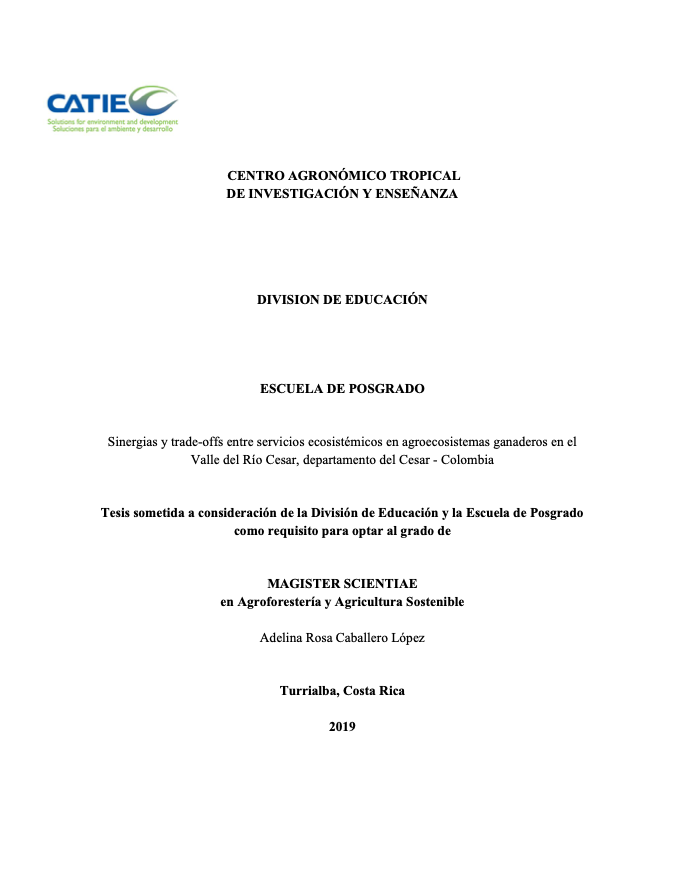
Sinergias y trade-offs entre servicios ecosistémicos en agroecosistemas ganaderos en el Valle del Río Cesar, departamento del Cesar – Colombia
Maestría en Agroforestería y agricultura sostenible; Catie; 74 p.
Resumen
The present study evaluated the floristic composition, the ecosystem service (ES) of regulation: carbon storage in aerial biomass and the supply ES: production of herbaceous forage and wood, also explored the relationships between pairs of SE and plant diversity in agroecosystems farmers of the ecoregion Valle Del Río Cesar, Department of Cesar (Colombia). The agroecosystems evaluated (AG) were constituted by naturalized pastures and different dispersed tree covers, these covers were categorized as high (20-40%), medium (10-20%) and low (5- 10%). Six farms located in three municipalities of the study area were selected and within these, the shade typology (percentage of tree cover) was verified, by measurement with spherical densiometer, in total 17 pastures were selected, six for high and medium coverage and Five down. The floristic composition in the herbaceous vegetation was evaluated in each pasture by drawing six linear transects of 50 m, using the cross method (Ospina et al. 2009) and three circular temporal plots (PC) were mounted for the tree vegetation. 1.000 m2 per paddock. The PC was also used to sample the supplied ES: forage and wood biomass and the regulation ES: carbon storage in aerial biomass. Relationships between ES pairs and plant diversity were explored using principal component analysis (PCA) and Spearman correlations. For the tree vegetation, 28 species belonging to 15 families and 25 genera were found, of these, four families (Bignoniaceae, Fabaceae / Mimosoideae, Fabaceae / Caesalpinioideae and, Fabaceae / Faboideae) represent 53,57% of the species and in the herbaceous vegetation 66 species were registered, corresponding to 51 genera and 23 families, more than 50% of the individuals detected belong to the Poaceae (27,27%), Euphorbiaceae (9,09%), Fabaceae / Faboideae (7,58%), and Malvaceae (7,58%). A pattern of dominance was identified in the AGs, characterized by a high abundance of few species, both in arboreal and herbaceous, Prosopis juliflora and Bothriochloa pertusa were the most dominant woody and herbaceous. Regarding the carbon storage ES, the ANOVA found significant differences in the coverage, with greater accumulation of total carbon (CT) in the high coverage (20,08 ± 0,84 t C ha-1), followed by the average (7,6 ± 0,4 t C ha-1) and low (2,88 ± 0,37 t C ha-1), the value was mainly influenced by carbon in tree biomass (CBA), a component that It also showed significant statistical differences, with superiority in high coverage. For the supply SE: production of herbaceous biomass (PMS) and wood (VLM), there were also significant statistical differences, the low coverage was higher in PMS (1,8 ± 0,2t MS ha-1), but similar to the mean coverage (1,68 ± 0,19 t MS ha-1), and statistically different from discharge (1,48 ± 0,19 t MS ha-1); on the contrary, the VLM was higher in the high coverage (24,81 ± 1,23 m3 ha-1), followed by the average (7,29 ± 0,33 m3 ha-1) and the low (1,6 ± 0,25 m3 ha-1). Finally, synergies were detected, but not trade- offs, between the SE and plant diversity.

